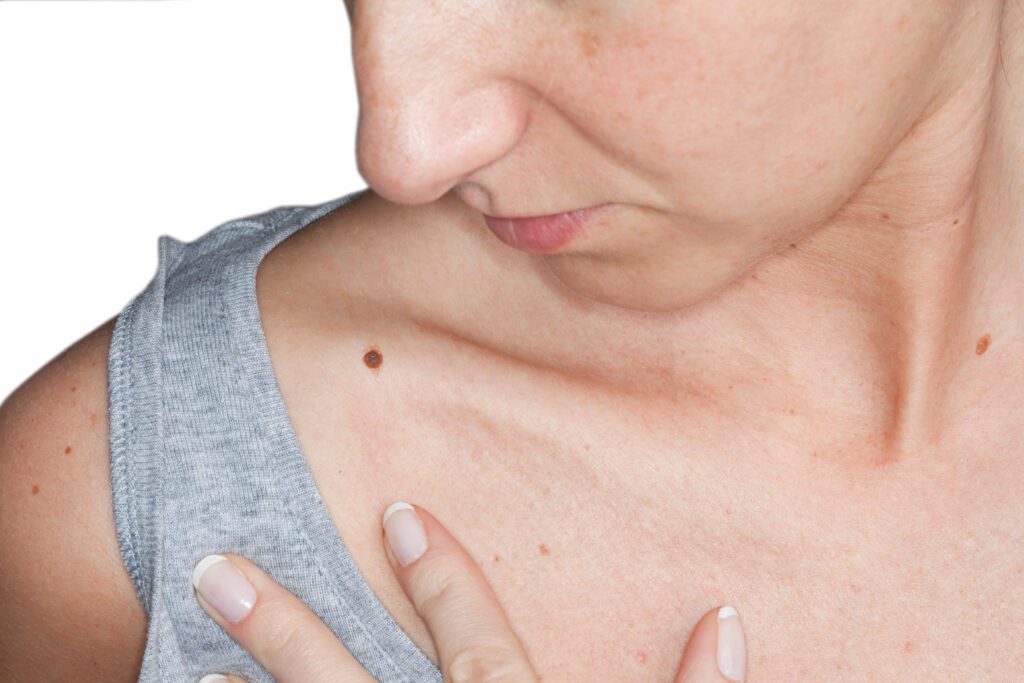Know the Risks and Signs Associated With Melanoma
by RYAN MILEJCZAK


Skin cancer is the most common type of cancer, with more Americans receiving a skin cancer diagnosis each year than all other cancer diagnoses combined. Melanoma is the least common form of skin cancer, but it’s also the deadliest. In fact, it causes more than 75% of all skin cancer deaths. This is because of its ability to metastasize to other parts of the body if left untreated.
Melanoma is a form of skin cancer that originates in your melanocytes, the cells in your body responsible for producing pigment in your skin. Like all cancers, it’s caused by the uncontrolled growth of abnormal or damaged cells. Melanoma can form anywhere on your body, but they’re most common in areas that are often exposed to the sun, such as your back, legs, arms, and face.
Anyone can develop melanoma, but a number of factors increase your risks, including:
- Fair skin
- Excessive exposure to UV light
- Living close to the equator or at a high altitude
- A family history of melanoma
- Having a lot of moles, especially certain types of moles
- A weakened immune system
- Older age
- A history of sunburns
This last factor is especially important for many Floridians.
“Living in the Sunshine State, it is especially important to remember that having five or more sunburns doubles your risk for melanoma,” explains Dr. Michael Steppie, President and Medical Director of Associates in Dermatology, which has locations in Polk & Osceola counties.
“Early detection of skin cancer is key,” he says. “Cure rates are high and recurrence rates are low for cancers that are caught and treated early.”
So what can you do to catch skin cancer early?
“The patient does not generally feel any symptoms of skin cancer but may notice a new or changing spot or a sore that will not heal,” Steppie says. “It’s important to know what to look for,” he adds, “specifically, what is referred to as the ABCDEs of melanoma.”
The ABCDEs of melanoma stand for five key signs of melanoma:
- Asymmetry. Melanoma lesions typically have irregular shapes, with one half being different from the other
- Borders. Melanoma lesions often have uneven borders, which are ragged, notched, or blurred
- Color: Melanoma lesions often contain many shades of brown or black, instead of having a uniform color
- Diameter: Melanoma lesions are often more than 6mm in diameter (about the size of a pencil eraser)
- Evolution. Changes in the size, shape, symptoms (such as itching or bleeding), or color of a mole.
In advanced stages, there may also be associated symptoms such as pain in an area close to the affected spot. If you have any of these signs or symptoms, you should see a doctor to have them take a look.
Presently, a number of treatments are used to treat melanoma, including radiation therapy, surgery, and chemotherapy. But with recent advancements in our understanding of melanoma, we may soon be able to treat and prevent this disease even more effectively.
One exciting new treatment is the use of mRNA vaccines, similar to those used to treat Covid-19. Moderna and Merck recently finished phase 2 trials for this new treatment, which could significantly reduce the risk of melanoma relapse in those who have recovered from the disease.
The technology works by using genetic material from a person’s tumor. This is then used to create a personalized mRNA vaccine that teaches the immune system to identify and attack cells that match the tumor before they have a chance to grow.
Researchers at Tel Aviv University in Israel have also made groundbreaking discoveries about how melanoma spreads. The research showed that melanoma cells actually alter their environment to spread through the body. They do this by secreting what are known as melanosomes. These melanosomes then penetrate lymph vessel cells, sending a signal to replicate and migrate, forming more lymph vessels near the tumor. This enables the melanoma to spread and metastasize.
Understanding this mechanism will hopefully contribute to developing an effective vaccine. Because melanoma is only deadly if it metastasizes, understanding how to stop that process could save countless lives
Advances like these could help make melanoma easier to prevent, and much less deadly. But until then, be sure to protect yourself by watching out for warning signs of melanoma and getting regular screenings.
